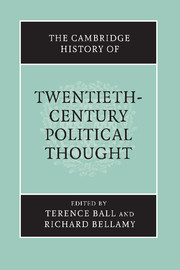Book contents
- Frontmatter
- Editors’ introduction
- Part I The changing fortunes of liberal democracy
- 1 The coming of the welfare state
- 2 Politics and markets: Keynes and his critics
- 3 The advent of the masses and the making of the modern theory of democracy
- 4 Nationalism and imperialism
- 5 Fascism and racism
- 6 Conservatism
- 7 Christian democracy
- 8 Critics of totalitarianism
- 9 The end of the welfare state?
- Part II Varieties of Marxism
- Part III Science, modernism and politics
- Part IV New social movements and the politics of difference
- Part V Beyond Western political thought
- Biographies
- Bibliography
- Subject index
- Name index
- References
1 - The coming of the welfare state
from Part I - The changing fortunes of liberal democracy
Published online by Cambridge University Press: 28 March 2008
- Frontmatter
- Editors’ introduction
- Part I The changing fortunes of liberal democracy
- 1 The coming of the welfare state
- 2 Politics and markets: Keynes and his critics
- 3 The advent of the masses and the making of the modern theory of democracy
- 4 Nationalism and imperialism
- 5 Fascism and racism
- 6 Conservatism
- 7 Christian democracy
- 8 Critics of totalitarianism
- 9 The end of the welfare state?
- Part II Varieties of Marxism
- Part III Science, modernism and politics
- Part IV New social movements and the politics of difference
- Part V Beyond Western political thought
- Biographies
- Bibliography
- Subject index
- Name index
- References
Summary
The welfare state – the overriding objective of domestic politics in most developed Western states during the first half of the twentieth century – was a product of fundamental changes in the conceptualisation both of welfare and of the state. Evolving accounts of human nature and of the interdependence between individual and society were supplemented by structural experimentation with various measures intended to secure the realisation of those understandings. They were also accompanied by competing ethical and conceptual interpretations of rights, duties, responsibilities and agency. Moreover, they were nourished within opposing ideological families that sought to be sharply distinguished from one another, yet displayed overlapping and complex configurations of ideas. Variations in time and space account for some important differences of emphasis, but also demonstrate that shared pools of ideas were drawn upon from which these local divergences emanated.
Ideological disparities
At its zenith in the mid-twentieth century, the welfare state was frequently defined as one in which the power of a democratic state is deliberately used to regulate and modify the free play of economic and political forces in order to effect a redistribution of income (Schottland 1967, p. 10). This definition, like any other, conveys a particular interpretation, in this case one that presupposes a state-instigated deviation from a market norm, as well as the absence of ‘modification’ or intervention in earlier welfare arrangements – both highly contestable assumptions. It also fails to differentiate between the practices of welfare as insurance and as assistance, or between welfare as the guaranteeing of minimal material conditions and welfare as human flourishing in broad, even optimal senses.
- Type
- Chapter
- Information
- Publisher: Cambridge University PressPrint publication year: 2003
References
- 10
- Cited by

